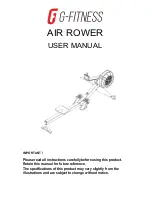
Subject to change without notice
32
any external connections). Using the test prods, identical test
points in each circuit can be checked, and a defect can be
determined quickly and easily.
Possibly the device itself under test contains a reference circuit
(e.g. a second stereo channel, push-pull amplifier, symmetrical
bridge circuit), which is not defective.
Adjustments
As described in the
“Menu”
section, the instrument`s software
contains the menu
“TEST & CALIBRATE”
. Calling this menu
causes the submenus
“TEST”
and
“CALIBRATE”
to be
displayed.
“RO POSITION”
is displayed after
“TEST”
was called. After
calling
“RO POSITION”
four rectangles are displayed. The
rectangles position and size should coincide with the CRT
graticule lines. In spite of the CRT mumetal shielding, deviations
of up to 1mm are unavoidable due to the influence of the earth
magnetic field.
The following items can be used by operators not equipped with
precision instruments. After the required warm-up time of 20
minutes, first the instrument must be switched off and on again
with the AUTOSET button pressed constantly until the main menu
becomes visible. In the
“CALIBRATE”
submenu the following
items can be chosen:
Y AMPLIFIER
and
TRIGGER &
HORIZONTAL
.
Each item is called by pressing the SAVE /
SET
pushbutton. Then
the instrument automatically adjusts and stores the adjustment
values. In case of the Y amplifiers these are the field effect
transistor‘s operating points, the invert and the variable gain
balance. For the trigger amplifier it is regarding the DC operating
points and the trigger threshold.
RS232 Interface
Safety
Caution:
All terminals of the RS232 interface are galvanically
connected with the oscilloscope and subsequently with
protective (safety) earth potential.
Measurement on a high level reference potential is not permitted
and endangers operator, oscilloscope, interface and peripheral
devices. In case of disregard of the safety warnings contained in
this manual, HAMEG refuses any liability regarding personal injury
and/or damage of equipment.
Operation
The oscilloscope is supplied with a serial interface for control
purposes. The interface connector (9 pole D- SUB female) is
located on the rear of the instrument. Via this bi-directional port,
the instrument parameter settings can be transmitted to, or
received from a PC.
The maximum connecting cable length must be less then 3
meters and must contain 9 screened lines connected 1:1. The
pin connection of the oscilloscope RS232 interface (9 pole D-
SUB female) is determined as follows:
Pin
2
Tx data (data from oscilloscope to external device)
3
Rx data (data from external device to oscilloscope)
7
CTS
(clear to send)
8
RTS (request to send)
5
Ground (reference potential - connected via the
oscilloscope’s power cord with protective earth)
9
+5V supply voltage for external devices (max. 400mA)
The maximum voltage swing at pin 2, 3, 7 and 8 is ±12 volt.
The RS232 parameter are:
N-8-2
(no parity bit, 8 data bits, 2
stop bits, RTS/CTS hardware protocol).
Baud-Rate Setting
After the first POWER UP (switching on of the oscilloscope ) and
the first command SPACE CR (20hex, 0Dhex) sent from the PC,
the baud rate is recognized and set automatically between 110
baud and 115200 baud. The oscilloscope is then switched over to
REMOTE control mode. The oscilloscope then transmits the
RETURNCODE: 0 CR LF to the PC. In this status all settings
(with the exception of those functions mentioned under “Controls
and Readout”) can be controlled via the interface only.
Adjustments





































